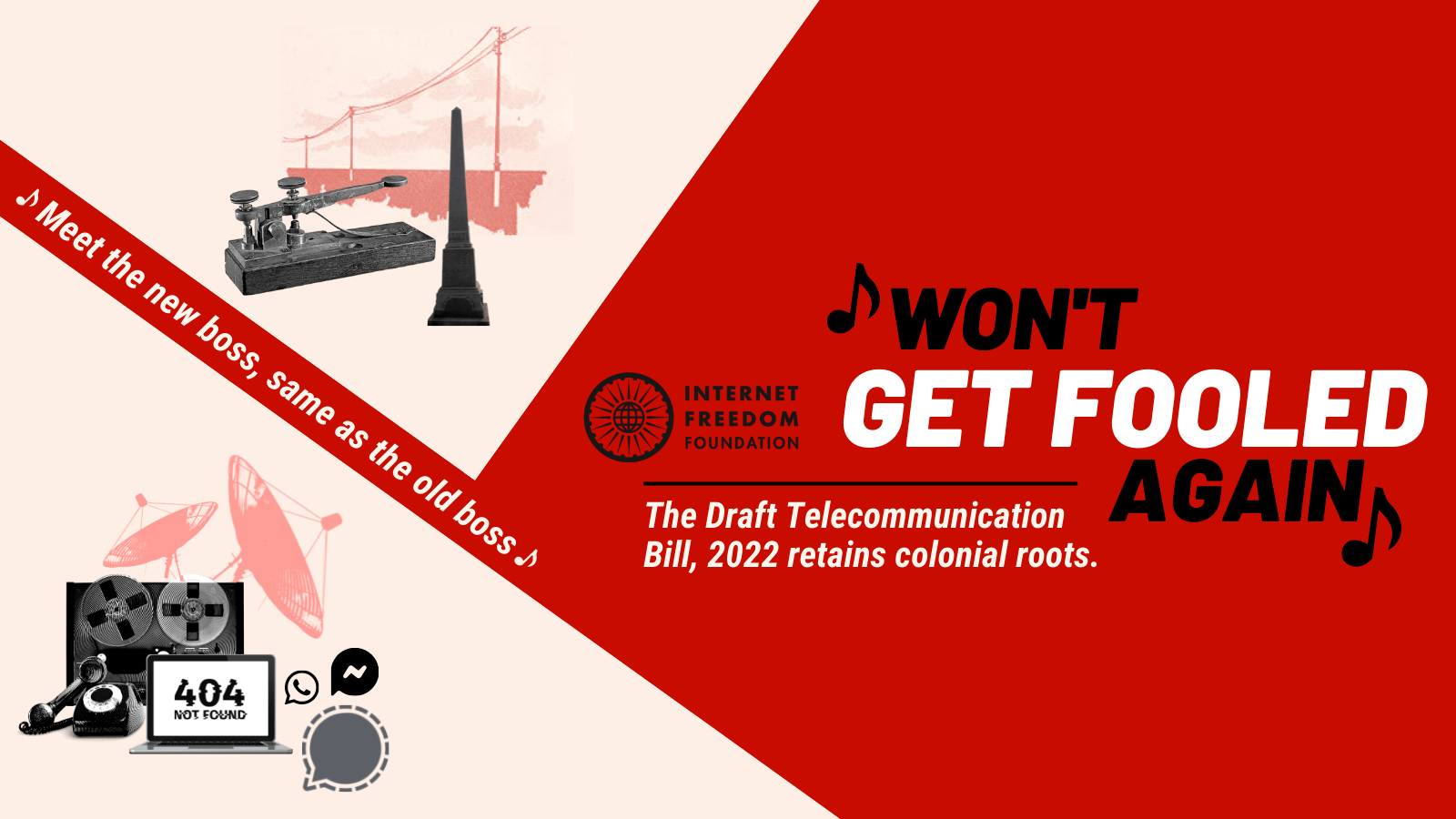
tl;dr
The Department of Telecommunications (DoT) under the Ministry of Communications (MoC) has released for public consultation the draft of the Indian Telecommunication Bill, 2022. According to the accompanying explanatory note, the Bill aims to create a comprehensive framework for the regulation of telecommunications in India. In doing so, it repeals the Indian Telegraph Act, 1885, Indian Wireless Telegraphy Act, 1933, and The Telegraph Wire (Unlawful Protection) Act,1950. Comments on the draft from relevant stakeholders have been invited till October 20, 2022. The comments can be sent to [email protected].
Background
According to the explanatory note which accompanies the draft Indian Telecommunication Bill, 2022 (“Bill”), it aims to provide a modern and future-ready legal framework for the regulation of telecommunications in India. It consolidates the laws governing provision, development, expansion and operation of telecommunication services, telecommunication networks and telecommunication infrastructure and assignment of spectrum. As a result, it repeals the Indian Telegraph Act, 1885, Indian Wireless Telegraphy Act, 1933, and The Telegraph Wire (Unlawful Protection) Act,1950 while amending certain provisions of the Telecom Regulatory Authority of India Act (TRAI), 1997. However, it does not repeal any rules, guidelines or administrative orders, already made or purported to have been made under these legislations, which, as per Clause 52 of the Bill, shall continue to be in force. Further, it states the Central Government may prescribe rules under this Bill for “the grant of licence, registration, authorization or assignment, their terms and conditions and payments”.
The Bill has been developed through a public consultative process. It purportedly takes into account the comments received from stakeholders and industry associations on the consultation paper on the “Need for a new legal framework governing Telecommunication in India” which was published on July 23, 2022 (Read our comments on the paper here). It is also open for further consultation, which the public can participate in by providing comments to [email protected].
Expanded definitions clause
Perhaps the most important change made through the Bill is the widely expanded definitions clause. Previously provisions of the existing acts, which were enacted before the advent of modern technology, were interpreted widely to regulate new technologies. The Bill through its expanded definitions clause makes specific reference to modern technologies, in an attempt to be comprehensive. This allows the Bill to solve ongoing confusion which has plagued the interpretations of its predecessor legislations when their application over modern technology was contested before courts.
Here, the definition of “telecommunication services” as contained in Clause 2(21) requires specific study. The definition of “telecommunication services” has been expanded to include service of any description which is made available to users by telecommunication which includes:
- broadcasting services: Schedule 2 of the Bill lists certain broadcasting services which would be required to obtain a licence. These services are as following:
a. Direct to Home (DTH) Services (Dish TV, Doordarshan),
b. Community Radio Stations (Radio Udaan, Punjab),
c. FM Radio Broadcasting Services through Private Agencies (Radio Mirchi)
d. Internet Protocol Television (IPTV) Services (MNTL),
e. Downlinking of Television Channels,
f. Uplinking of Television Channels. - electronic mail, (Gmail)
- voice mail, (Airtel)
- voice, (TSPs such as Vodafone)
- video communication services, (skype)
- data communication services,
- audiotex services,
- videotex services,
- fixed and mobile services (BSNL)
- internet and broadband services (Act Fibernet)
- satellite based communication services (TSPs such as Bharti Airtel)
- internet based communication services (ISPs such as Reliance Jio)
- in-flight and maritime connectivity services (Tatanet)
- interpersonal communications services (WhatsApp, Signal)
- machine to machine communication services (smart watch, smart tv)
- over-the-top (OTT) communication services (Google Meet, Facetime, Jitsi)
Some services included in the list above may overlap with each other, however they have been included as a separate category to keep true to the definition provided by the Bill.
Some of the above mentioned services were already included in the definition of “telecommunication services” as defined by the TRAI Act, 1997 (Point 2, 3, 6, 7, 8, and 9). Additionally, through a notification dated January 9, 2004, the Central Government included ‘broadcasting and cable services’ under TRAI’s ambit. However, the Bill makes new additions in the definition which includes services such as OTT and interpersonal communication services, where providers deliver audio, video and/ or messaging services via the internet, bypassing the traditional cable/ broadcast operators. The expansion of this definition has far reaching implications for the telecommunications sector, which we will explain in the following sections.
Licensing
Clause 3(1) of the Bill provides the Central Government with the exclusive privilege to
- provide telecommunication services,
- establish & operate telecommunication networks and infrastructure, and
- Use and allocate spectrum.
In exercise of this privilege, Clause 3(2) of the Bill, allows the Central Government to prescribe licences for providing telecommunication services or establishing, operating, maintaining and expanding telecommunication networks. Clause 4(1) states that this privilege will be provided procedure through rules that the Central Government may prescribe at a later date for payment of entry fees, licence fees, registration fees or any other fees or charges. Thus, each service included in the list of services in the definition of “telecommunication services” will now have to obtain a specific licence to operate in India. In addition to expanding its own powers for granting licences, the Central Government has also diluted the powers of the Telecom Regulatory Authority of India (TRAI) under Clause 46 of the Bill. For this, they have deleted certain key provisions of the TRAI Act, 1997 under which the government, prior to issuing a licence to a service provider, had to ask the regulator, i.e, TRAI, for recommendations.
The move towards regulation of OTT communication services has not only been a demand raised consistently by TSPs, but also something that has been considered by TRAI and DoT in the past. This Bill has essentially cemented this provision by expanding the definition of “telecommunication services”. This will result in additional cost and compliance burden for small service providers, and affect the vibrant innovation culture of India.
The creation of a licensing regime for providers of OTT communication services has been a consistent demand of traditional telecom service providers (TSPs). According to TSPs, the lack of equal or same regulations over OTT communication service providers creates an uneven playing field, since according to the TSPs, OTT services are a “substitute” of the services provided by them. Additionally, TSPs also argue that the increasing use of OTT communication service providers by users has led them to suffer from loss of revenue due to loss of market share.
TSPs have in the past placed the blame on internet platforms and services for somehow having stolen profits from telecom companies by voice calling and instant messaging services. This builds into arguments for levying some form of a toll to "compensate" telcos for their losses. Back in 2020, when TRAI released a consultation framework on ITT regulation, we conducted a preliminary analysis to question this very economic premise (You can also read our summary and an analysis of the OTT Consultation Paper over here). Below are our findings, in brief:
- Both voice and data usage have seen a significant increase in the past few years. This exploded after Q2, 2016 which is when Reliance Jio started its services. The rate of growth is increasing and more people are coming online.
- This massive growth has coincided with a drop in per user revenue for the major telecom players. Such fall appears to be due to a hyper-competitive environment after the entry of Reliance Jio, however with a wave of consolidation this period may soon end. These trends are as per statements in the press by leading executives of telecom companies and analyst reports such as Moody's and Fitch.
Thus, from a data perspective, devising regulations to place regulatory burdens or financial levies on internet platforms and services is not a sound public policy. To us, this is again illustrative of the reductiveness of a debate that commences from dulling the feature richness and diversity of internet applications and services into the straitjacket of OTT.
We also dispute the arguments for substitutability of services between telcos and internet applications and services. The latter quite often offer multiple functionalities—which may include voice calling and instant messaging—even though their primary functionality, for instance, may be social networking. With WebRTC, nearly all browser based content and mobile applications can have a communications layer that supports messages, voice, and video. Will such services also be brought within the regulatory ambit?
Further, the ‘same service same rules’ argument used by TSPs are unfounded as there are inherent structural differences between telecom and OTT communication service providers. Moreover, while telecom operators control the underlying broadband access infrastructure, and are the gatekeepers to broadband internet access, OTT services do not have these controls. Thus, a move to introduce such overburdening regulations on the latter based on a narrative of ‘same service, same rules’ may cause anxiety not just to them, but also the OTT service users.
Lastly, Clause 4(7) requires every entity receiving a licence to “unequivocally identify the person to whom it provides services, through a verifiable mode of identification as may be prescribed.” Additionally, as per Clause 4(8), the identity of the sender of a message using telecommunication services “shall be available to the user receiving such message, in such form as may be prescribed, unless specified otherwise by the Central Government”. These provisions essentially strip away the user’s right to stay anonymous and puts an obligation on service providers to identity, with complete assurity, every user. Such a broad and excessive requirement, in the absence of a data protection law, fails to prioritise user safety and security.
Surveillance
Clause 24(2)(a) of the Bill replicates the requirements of S. 5(2) of the Telegraph Act, 1885 with one major change. S. 5(2) currently authorises the interception of messages transmitted through a telegraph as part of the surveillance framework in the country by the Central or State Government, or any officer authorised on their behalf. While Clause 24(2)(a) of the Bill contains the same requirements, it expands the scope of the surveillance to “telecommunication services or telecommunication network”. As a result, OTT communication service providers such as Whatsapp, Signal etc., which practise the privacy protecting process of End-to-End encryption (E2EE), may now also be required to not transmit, or intercept or detain or disclose any message or class of messages to the officer specified in the surveillance request/order. Encryption is also undermined by Clause 4(7) and 4(8) of the Bill, which require licenced entities to “unequivocally identify” all its users, and make such identity available to all recipients of messages sent by such user.
While this is concerning, it is not the first attempt made by the Government to get OTT communication service providers to allow surveillance. Previously, the Information Technology (Procedure and Safeguards for Interception, Monitoring and Decryption of Information) Rules, 2009 have also attempted to require OTT communication service providers to break E2EE and allow decryption. Further, the Information Technology (Intermediary Guidelines and Digital Media Ethics Code) Rules, 2021 also contain provisions requiring significant social media intermediaries to enable tracing of the originator of information on their platform (“traceability”). However, these are currently under challenge before the Supreme Court of India. It remains to be seen how the OTT communication service providers will respond to the present Bill.
Here, it is important to note that the surveillance provisions contained in the Bill represent a missed opportunity for the Government. The Bill does not reflect improvements to India’s surveillance architecture on the basis of privacy, transparency, and accountability. Even where the Bill has tried to bring in certain safeguards through the ‘public safety’ and ‘public emergency’ requirements, it must be noted that the power to intercept messages transmitted through a “computer resource” already exists under S.69 of the Information Technology Act, 2000. However, S. 69 does not contain the ‘public safety’ and ‘public emergency’ requirements. Effectively, this means the Government can bypass the ‘public safety’ and ‘public emergency’ threshold by conducting the surveillance under S.69 of the existing IT Act. This makes the procedural safeguards provided under 24(2) essentially meaningless.
The Right to Privacy decision of the Supreme Court as well as the Srikrishna Committee Report have expressed the urgent need for surveillance reform. However, the Bill misses this opportunity for significant legislative reform based on the knowledge and experience which has been accumulated post independence. Instead, it replicates the colonial moorings of the Telegraph Act, 1885 by transplanting essentially the same provision onto this new Bill and ultimately fails to be the custodian of India’s telecommunications sector in the 21st century.
Concerns around data localisation requirements also arise as a result of the move towards licensing OTT communication services. The government may now ask these services to store data, including personal and sensitive information such as our private conversations, locally, in India. Such a licensing requirement confers excessive discretion to the government, and adversely affects the privacy of individuals (Read more about our concerns with and the threats posed by data localisation norms here).
This is not the first time that data localisation norms for OTT communication services have been suggested. Back in 2020, when TRAI released the consultation paper on regulatory framework for OTT Services, various stakeholders, who were in favour of cross-border data transfer, raised concerns about the government’s inability to intercept personal communications and information stored in data servers located abroad in the absence of data localisation norms.
Internet Shutdowns
Clause 24(2)(b) of the Bill for the first time provides a clear internet suspension power, which did not exist as clearly before. However, it fixes none of the issues of the Temporary Suspension of Telecom Services (Public Emergency or Public Safety) Rules, 2017. The Bill fails to enact any provisions for judicial oversight over the suspension orders or to strengthen the powers of the review committee. Here again, there is a missed opportunity for legal reform. The Supreme Court in Anuradha Bhasin v Union of India has stated that expressing one’s views or conducting one’s business through the internet are protected under Articles 19(1)(a) and 19(1)(g) of the Constitution respectively. Further, the Standing Committee on Information Technology in its reports on internet shutdowns has also made a range of recommendations including a review of the legal regime for suspension of internet services, as it found the Department of Telecommunications’ existing process lacks sufficient safeguards. Here, it is pertinent to note that the Bill not only fails to safeguard the rights of citizens but also fails to protect their economic interests. This failure results in the Bill failing to fulfil its stated objective which is to bolster economic growth as it identifies telecommunication as a key driver of socio-economic development.
Conclusion
Provisions of this Bill are, in spirit and to some extent the letter, the same as the provisions of the Indian Telegraph Act, 1885, creating the same concerns, threats and issues. Except, the concerns have gotten worse. The sense of victory that we first felt in September 2020, when TRAI issued clear recommendations against the regulation of OTT communication services, broadly in support of user choice and demands made by digital rights organisations, has unfortunately been short-lived. In anticipation of a new Bill that would finally do away with the colonial-era law that was the Indian Telegraph Act, we had hoped for a favourable outcome as one received in the fight for net neutrality. While this is a victory for the large telecom companies, it is a loss for innovation, transparency, privacy, and user rights.


